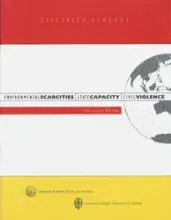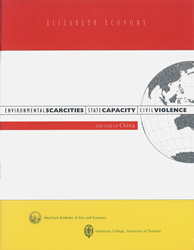The Case of China

 The Case of China
Author:
The Case of China
Author:Elizabeth Economy
(Cambridge: American Academy of Arts & Sciences, 1997)
Summary of the China Case Study
Since 1978 and the onset of reform in China, water scarcity in many regions of China has intensified. Unrestrained economic development and rapid societal change without attention to the ramifications of these transformations for the environment and natural resources have placed China's threatened water supply under tremendous stress. Population and water use per capita are growing; the physical condition of China's water facilities is aging; competition between potential uses for water is up; aquifers are becoming depleted; water pollution is rising; and the social cost of subsidizing water usage is increasing.
Chinese residents face a shortage of 28.8 million cubic meters of water daily. AThese shortages cost the Chinese economy between 5 and 8.7 billion yuan (US$620 million and 1.06 billion) in 1990. The China case study examined the impact of the growing water scarcity on state capacity. It concludes that while water scarcity contributes to diminished state capacity, it does so in an indirect manner and over the long term. The more compelling story is that political and economic reforms are transforming the very nature of the state. This process, in turn, has implications for the overall capacity of the state to develop and implement the policies necessary to respond to water scarcity in the PRC.
The reform process has ramifications for the state's legitimacy, its fiscal strength, its coherence and its reach. Frequently, the relationship between the reforms and these factors is a negative one. The reforms have engendered an overwhelming emphasis on economic growth, a devolution of authority from central to provincial levels, a weak environmental protection bureaucracy relative to other industrial and economic agencies, and corruption at all levels of the Chinese bureaucracy. These trends contribute to diminish the efficacy of the state, but they also contribute to enhance state capacity. Institutional innovation within the system of environmental protection has extended the reach of the state, and greater openness to the international community has enhanced its fiscal strength.
The picture that is painted by these trends is a complex one. The Beijing leadership recognizes that the reforms have diminished state capacity as well as contributed to a growing range of natural resource related problems. However, its legitimacy is rooted in the continued exponential economic growth that these reforms have engendered during the past almost two decades. Thus, while Beijing is racing to redress the negative institutional and environmental ramifications of the reforms through campaigns, exhortations, and new laws, it is not willing (or in some cases not able) to implement policies that might slow the pace of economic development, such as raising the price of water, increasing pollution discharge fees, or devoting sufficient state financial resources for local water conservation or waste management projects.
In this scenario of overall diminishing state capacity and growing demand for resources, the impact of water scarcity on state capacity might be expected to be dramatic. However, it is not. In some respects, the potential negative ramifications are mitigated by opportunities presented through the transformation of state capacity by the reforms. Nonetheless, there are important signals that over the longer term, water scarcity may indeed significantly diminish state capacity in several key areas.
Both demand- and supply-induced scarcities of water are increasing demands on the state for new infrastructure such as dams, canals, wastewater treatment facilities, and irrigation systems. This is placing greater stress on the fiscal strength of the state. Beijing has attempted to shift a greater portion of the burden of financing these projects on to local and provincial governments as well as the international community. In many cases, however, the provinces lack the resources to make such substantial investments. Even Beijing has been stymied by the overwhelming costs associated with its desired river diversion project. In response to the growing responsibility of local leaders to pay infrastructure costs, they have used China's integration with the international community to turn to the international community for substantial funding assistance for these infrastructure projects.
While the short-term implications of this behavior appear relatively benign, there are potentially quite serious longer range ramifications for state capacity. First, the autonomy of the state may be diminished by a greater reliance on foreign lenders. These lenders not only provide financial aid but also insist on additional politically sensitive measures such as pricing reform. In addition, a diminished role for Beijing in the financing of projects and greater dependence on local sources of funding also suggests a longer-term decline in the reach of the state that will not be limited to resource management issues. Local leaders, especially at the provincial level, have become increasingly vocal in their opposition to some state policies. For example, the Sichuan governor's vocal response to Beijing's inadequate financial contribution for resettlement engendered by the Three Gorges Dam indicates a threat to legitimacy of the state. In its most extreme form, this loss of legitimacy and decline in the reach of the state contribute to social instability and violent demonstrations of the sort that have occurred among those slated for resettlement or already displaced along the Yangtze River.
Both demand- and supply-induced water scarcity result in substantial interprovincial conflict. Continued population growth, as well as increasing demands from industry and agriculture contribute to diminish the coherence of the state by engendering a growing number of interprovincial claims to these water resources. Rising pollution levels also result in growing interprovincial disputes over the responsibility and costs of treatment facilities and clean-up costs. These problems are endemic with little prospect for immediate resolution. Moreover, Beijing has yet to develop an effective mechanism for resolving such conflicts.
Water scarcity and pollution also occasionally have triggered violence in rural and urban areas. There is no evidence that these are more than isolated incidents with limited ramifications over the long term. It is worth mentioning, however, the extreme scenario in which such scarcity continues to grow, especially in urban areas, and a more sustained challenge to the authority of the state is posed. In combination with a contraction in the economy and the continued spread of corruption and abuse of power at both the elite and local levels, a much more threatening form of urban civil violence, involving migrant workers, unemployed state enterprise workers, grain-short urban dwellers, and disgruntled peasants might arise.
In the final analysis, water scarcity probably does not pose a substantial or direct challenge to state capacity. Moreover, as provincial and local regions grow wealthier, they may replace the center as the primary initiator and financial sponsor of environmental protection policies. Thus, while state capacity may be diminished in some respects, other elements of the state may emerge to respond more effectively to regional water demands. In this context, water scarcity in China should be considered a long-term threat to continued economic growth and state capacity that has yet to be acknowledged fully by the Chinese leadership. Even so, it remains a challenge that China may well meet as the economic and political reform process evolves.
Table of Contents
Summary
I. Introduction
-Hypotheses on Chinese Reform and State Capacity
-Hypotheses on Environmental Scarcity and State Capacity
II. Renewable Resource Scarcity Within China
III. The Backdrop to Water Scarcity: Economic, Political, and Societal
Transformation
-Demand-Induced Scarcity
-Supply-Induced Scarcity
-Future Trends in Economic Development and Water Scarcity
IV Beijing Municipality and Gansu Province
-Beijing Municipality
-Gansu Province
-Water Scarcity and State Capacity V Economic and Political
Transformation and State
VI. The Impact of Water Scarcity on State Capacity
VII. Conclusion